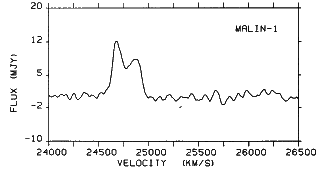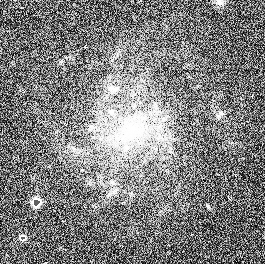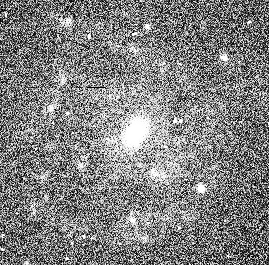


6.4. Discovering LSB Galaxies
With the concepts of diameter of apparent magnitude selection in mind
we can now engage in the following thought experiment.
Consider the
five hypothetical galaxies listed below. The first four have pure
exponential light distributions and similar total luminosity
(MB  -21.1); the fifth galaxy has the same scale length has
Galaxy B but a factor of 10 lower total luminosity.
This adheres to the McGaugh et al.
(1995) assumption that scale length and total luminosity are uncorrelated
in a representative sample of disk galaxies. Central suface brightness
(µ0 above) in the blue is now denotedby B(0).
-21.1); the fifth galaxy has the same scale length has
Galaxy B but a factor of 10 lower total luminosity.
This adheres to the McGaugh et al.
(1995) assumption that scale length and total luminosity are uncorrelated
in a representative sample of disk galaxies. Central suface brightness
(µ0 above) in the blue is now denotedby B(0).
 Galaxy A
Galaxy A
 l = 0.5 kpc B(0) =
16.0 mag arcsec -2
l = 0.5 kpc B(0) =
16.0 mag arcsec -2
 Galaxy B
Galaxy B
 l = 5.0 kpc B(0) =
21.0 mag arcsec -2
l = 5.0 kpc B(0) =
21.0 mag arcsec -2
 Galaxy C
Galaxy C
 l = 25.0 kpc B(0) =
24.5 mag arcsec -2
l = 25.0 kpc B(0) =
24.5 mag arcsec -2
 Galaxy D
Galaxy D
 l = 50.0 kpc B(0) =
26.0 mag arcsec -2
l = 50.0 kpc B(0) =
26.0 mag arcsec -2
 Galaxy E
Galaxy E
 l = 5.0 kpc B(0) =
23.5 mag arcsec -2
l = 5.0 kpc B(0) =
23.5 mag arcsec -2
Let's assume that the intrinsic space density of these five galaxies are equal and let's suppose that we conduct a survey to catalog galaxies which have diameters measured at the B = 25.0 mag arcsec -2 level of greater than one arcminute. Under these conditions, we are interested in determining the maximum distance that each galaxy can be detected:
Galaxy A: This galaxy is quite compact (ratio of 1/2 light diameter to D25 = 0.33) and would fall below the catalog limit beyond D = 60 Mpc.
Galaxy B: This is a typical large spiral (like M31);
D25 corresponds
to 3.74  l which is
18.7 kpc or a diameter of 37 kpc. This
projects to an angular size of 1 arcminute at D = 125 Mpc.
l which is
18.7 kpc or a diameter of 37 kpc. This
projects to an angular size of 1 arcminute at D = 125 Mpc.
Galaxy C: D25 corresponds to 0.45
 l or 11.5 kpc. This
projects to an angular diameter of 1 arcminute at D = 76 Mpc.
l or 11.5 kpc. This
projects to an angular diameter of 1 arcminute at D = 76 Mpc.
Galaxy D: D25 doesn't exist and this galaxy would never be discovered in such a survey.
Galaxy E: D25 corresponds to 0.92
 l or 4.6 kpc. This projects
to an angular diameter of 1 arcminute at D = 30 Mpc.
l or 4.6 kpc. This projects
to an angular diameter of 1 arcminute at D = 30 Mpc.
The total survey volume is defined by Galaxy B, as they can be seen to the largest distance. The ratio of sampled volumes for each of the other Galaxy types is considerably smaller. For instance, the volume ratio of Galaxy B to Galaxy E is a factor of 70! Hence, a survey like this would take the real space density distribution (which is equal) and, through the survey selection effect, produce a catalog which would contain 72% type B galaxies, 18% type C galaxies, 9% type A galaxies and 1% type E galaxies. Type D galaxies would not be represented at all. This is a severe bias which would lead us to erroneously conclude that there is predominately 1 type of disk galaxy in the Universe and this leads to Freeman's Law. Now in the real world of LSB galaxies, type C and D galaxies are quite rare but type E galaxies are common. Hence, their detection locally, automatically means the space density is relatively large because they are so heavily selected against.
For the purposes
of the rest of the discussion we define a LSB disk galaxy as one which
has B(0) fainter than 23.0 mag arcsec-2. This value is more than
4 removed
from the value Freeman found and, conveniently, is equal to the sky background
in the blue at a dark site such as Mauna Kea or Las Campanas Chile.
removed
from the value Freeman found and, conveniently, is equal to the sky background
in the blue at a dark site such as Mauna Kea or Las Campanas Chile.
The story of the discovery and characterization of LSB galaxies as important members of the general galaxy population really begins in 1963 with the publication of the David Dominion Observatory (DDO) catalog of galaxies by Sydney van den Bergh. This catalog consists of galaxies which exhibit a diffuse appearance and that have angular sizes larger than three arc minutes. While the DDO objects are the first bona fide collection of a sample of LSB galaxies they are not at all representative of the phenomena. The galaxies contained in the DDO catalog are exclusively of low mass (some are members of the Local Group of Galaxies). This has fostered an erroneous perception which continues to this day that all LSB galaxies are, in fact, dwarf galaxies. This is not correct as today, we know that all masses of galaxies have representation in the LSB class.
The first serious contribution to our understanding and recognition that LSB galaxies do exist was made by William Romanishin and his collaborators Steve and Karen Strom in 1983. They derived their sample from the UGC. While few of Romanishin et al. galaxies actually meet our defined criteria for LSB, their results nevertheless pointed out a class of galaxies that had somewhat unusual properties, in particular, they had relatively large amounts of gas for their luminosity. By 1984, Allan Sandage published some of the first results on his Las Campanas Photographic Survey of the Virgo Cluster. Contained in those papers were some vivid examples of dwarf galaxies in the Virgo cluster which were quite diffuse and were an extension towards lower surface brightness of the DDO objects discovered 20 years earlier.
With these two studies, it became clear that some quite diffuse galaxies do exist. Their existence raises five fundamental questions:
1) Since optical redshift surveys are biased against the detection of LSB galaxies, has our view of Large Scale Structure been biased because of the failure to include this population?
2) How can such diffuse and apparently fragile systems in the Virgo cluster be stable against tidal disruption by other cluster members or by the mean tidal field of the cluster?
3) Has failure to account for LSB galaxies significantly biased the determination of the GLF?
4) Could large numbers of hitherto unknown LSB systems be responsible for the plethora of observed QSO absorption lines?
5) Do LSB galaxies represent a different form of disk galaxy evolution from that which produces the Hubble sequence of spirals?. To set about answering these questions requires a large, systematic survey to detect and measure the properties of LSB galaxies. In 1985 this survey was begun by Chris Impey and Greg Bothun and is still ongoing.
The initial aspects of the survey concentrated on obtaining 21-cm redshifts of all LSB galaxies that were in the UGC and investigating the Virgo Cluster to see if there were still more diffuse galaxies that had been missed in the Las Campanas Survey. To improve the sensitivity of the search in Virgo, David Malin agreed to use his photographic amplification technique (see Malin and Carter 1980) on selected one degree regions of the Virgo cluster using UK Schmidt Plates. The Malin survey was going well and we were identifying very diffuse objects as candidates for LSB galaxies missed in the Las Campanas Survey. Verification of these candidates was through follow-up CCD imaging. Several candidates were found and verified but among them was a galaxy which was to become known as Malin-1 and take its place as the largest disk galaxy every discovered. The fact that such a galaxy could remain undiscovered for so long is powerful testimony to the severity of surface brightness selection effects.
Malin-1 first stood out as unusual in the CCD survey
on the basis of
its morphology. In contrast to the other objects which were structureless
and extremely diffuse, Malin-1 appeared to have very faint spiral structure
which was connected to a point-like nuclear region. On the Palomar Sky survey
this nuclear region is visible as a faint star but no associated nebulosity is
apparent. Figure 6-9 shows the difference
between the Sky Survey image and
the photographically processed image obtained by Malin. The brightness
of the stellar-like nucleus of Malin 1 was sufficient to obtain its
spectrum using the 200-inch telescope. In 1986 May, a spectrum was obtained
which showed an obvious emission line due to [O II]
 3727.
This line was redshifted to z = 0.083,
indicating the object was well in the background to the Virgo cluster
(z = 0.004).
The problem was, that the total angular size of the object on
our CCD frame (Figure 6-9)
was approximately 2.5 arcminutes yet it apparently was 20
times farther away than Virgo. A quick scaling then indicates that if a
galaxy like this was indeed in Virgo then its angular size would be a degree.
If it were as close as the Andromeda Galaxy its angular size would be about
20 degrees and of course we would look right through it and never know
its there. This seemed like such an absurd situation for the structure
of any galaxy. If real, this galaxy would then turn out to be the
largest known disk galaxy yet it was found in a survey that was looking
for extremely LSB dwarf galaxies in the Virgo cluster. The expectation
then, was that Malin-1 was a composite system consisting of a background,
nucleated emission line galaxy that just happened to be located behind
a LSB dwarf galaxy in Virgo. This supposition could be verified through
a 21-cm detection of the system at the Virgo cluster redshift.
3727.
This line was redshifted to z = 0.083,
indicating the object was well in the background to the Virgo cluster
(z = 0.004).
The problem was, that the total angular size of the object on
our CCD frame (Figure 6-9)
was approximately 2.5 arcminutes yet it apparently was 20
times farther away than Virgo. A quick scaling then indicates that if a
galaxy like this was indeed in Virgo then its angular size would be a degree.
If it were as close as the Andromeda Galaxy its angular size would be about
20 degrees and of course we would look right through it and never know
its there. This seemed like such an absurd situation for the structure
of any galaxy. If real, this galaxy would then turn out to be the
largest known disk galaxy yet it was found in a survey that was looking
for extremely LSB dwarf galaxies in the Virgo cluster. The expectation
then, was that Malin-1 was a composite system consisting of a background,
nucleated emission line galaxy that just happened to be located behind
a LSB dwarf galaxy in Virgo. This supposition could be verified through
a 21-cm detection of the system at the Virgo cluster redshift.

|
Figure 6-9: The original CCD image, taken in Blue light, of Malin 1 from Bothun et al. (1987). The field size is appoximately 3.5 x 2.5 arcminutes. |
In October 1986, several 21-cm observations of Malin-1 were made with
the Arecibo radio telescope. The system was not detected in H I
emission at the Virgo cluster redshift but many hours of integration did
produce a superb upper limit on any flux. After failing to detect
the system at the Virgo cluster redshift, Arecibo was tuned to the
emission line velocity as measured off the 200-inch spectrum. After
10 minutes of integration a very large signal
at 21-cm was detected at the emission line velocity. The signature of
the 21-cm profile was exactly that of a rotating disk galaxy and is
shown in Figure 6-10. This then provided
confirmation that Malin-1
indeed was a huge disk galaxy that was very, very diffuse. The
point-like structure in its center turns out to be the bulge component
of Malin-1
which hosts a weak AGN. Surface photometry from the CCD frame combined
with the now known distance to Malin-1 revealed a scale length of
55 kpc (this is 20 times larger than
our galaxy) and a central surface brightness of B(0) = 26.0 mag
arcsec-2. This
is  15
15
 fainter than Freeman's Law and
the galaxy had
been discovered accidentally. Malin-1 is Disney's crouching giant
and if there was one, there many more. The issue now became one of engaging
in a larger survey to better determine the space density of these LSB galaxies.
fainter than Freeman's Law and
the galaxy had
been discovered accidentally. Malin-1 is Disney's crouching giant
and if there was one, there many more. The issue now became one of engaging
in a larger survey to better determine the space density of these LSB galaxies.

|
Figure 6-10: 21-cm profile of Malin 1 obtained by Bothun etal (1987) which confirms the object as being well behind the Virgo cluster. |
Three new surveys were then initiated all with the goal to discover, using various techniques, the extent and nature of this new population of galaxies which had low contrast with respect to the sky background and hence have remained undetected and uncatalogued. These surveys were 1) a visual search of the new Palomar Observatory Sky Survey plates in a declination strip centered on 20° (so that the objects are accessible from Arecibo); 2) Applying the Malinization technique to UK Schmidt Plates of the Fornax cluster to see if a similar population of very diffuse dwarfs to that in Virgo could be identified and 3) using the Automatic Plate Machine (APM) to scan UK Schmidt plates using an algorithm optimized to find galaxies of low contrast.
These surveys have largely been completed (and newer wide field CCD surveys are now underway). Between them they have discovered approximately 1000 new, nearby galaxies, that have been the subject of extensive followup. A gallery of some selected members of the LSB class of galaxies is shown in Figure 6-11. The establishment that LSB galaxies are real and occur in the universe in significant numbers (see below) has opened up a new field of inquiry in extragalactic astronomy and now many others are involved with learning more about this population. Thus, in just over a decade a whole new population of galaxies has been discovered. These LSB galaxies are of cosmological significance and have properties which are different from those of their higher surface brightness counterparts which currently are dominant in extant galaxy catalogs.

|

|

|

|
Figure 6-11: A selection of various LSB galaxies from the semi-obvious to the barely detectable. |